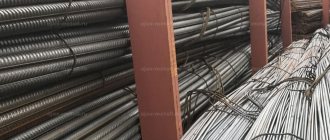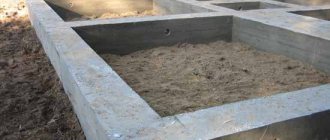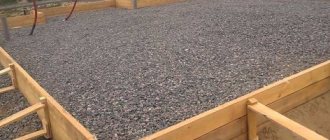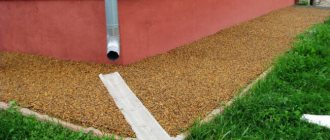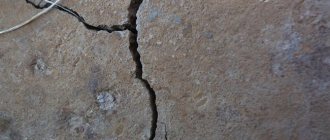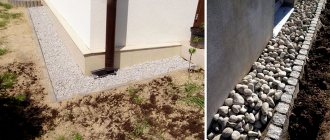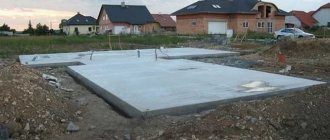To build a foundation, it is worth considering the proportions of cement and sand for the foundation, so that at the end you get a solid structure that will be famous for its durability. Not a single modern foundation construction can take place without preparing concrete; construction work without it will be irrational.
It consists of the following components: sand, cement, and water. There are, of course, times when it is necessary to add crushed stone. At the construction stage, it is imperative to pay attention to the proportions of all components, because it will probably not be possible to create a high-quality solution.
As a result, the finished foundation will not be characterized by improved operating qualities; accordingly, it will show itself to be short-lived, and you can completely forget about strength.
Cement to sand ratio
Surely many people know that the solution should contain not only water and cement - this is unacceptable. If the foundation is based exclusively on such components, the foundation will be unreliable and not resistant to frost.
In addition, if the foundation of the house is created exclusively from water and cement, it will soon shrink seriously, and such construction will also be very expensive. Therefore, it is additionally worth using sand, which will serve as a filler.
Sand
How to dilute cement with sand? Its proportion should directly depend on the brand of cement purchased. So, if you purchased M400, then for one part you need to take 4 parts of sand. But it is worth noting that there are a number of cases when the percentage changes.
M-400
During the construction of the foundation for brick structures, the ratio should change to 1:3, and during the construction of the foundation for a wooden house to 1:6. When using M500 , the percentage should be 1:5.
M-500
What is the proportion of cement to sand for the foundation?
Mix all the ingredients using the classical technique. Initially, cement is added to the mixture, then sand and water are gradually added.
The last component should be 1⁄2 parts.
Concrete composition
It is extremely difficult to guess the correct ratio of water; the basis should be the moisture content of all the initial components. If sea sand and cement were purchased, then water consumption should be minimized, but if the components are as dry as possible, then on the contrary, it should increase.
All experts recommend mixing concrete in small portions. If you follow this rule, it will set quickly.
It is worth paying attention to the pauses between batches; they should not be as long as possible, not exceeding 120 minutes.
The consistency of the solution itself should resemble sour cream. When its thickness does not meet these recommendations, add a little water.
Concrete recipe - everything has already been invented for us
Calculator for calculating the selection of concrete composition
Not a single legally binding regulatory document regulates the specific proportions of sand and cement for concrete. There are too many factors influencing this. But some provisions on the recipe can be found in GOST 27006-86 “Concrete. Rules for selecting the squad."
Again, it reflects everything in general terms. But I just want to know how much cement, sand, crushed stone is in 1 m3 of concrete of a particular brand. Such an opportunity exists today - composition selection calculators.
You simply enter the required class and brand of cement and get the desired recipe. But you should not treat it as a truly correct option. These figures are approximate.
The tables above show the approximate rates of cement, sand, and crushed stone for the most popular brands of concrete. Such values need to be adjusted after laboratory tests of test batch samples.The ratio of sand, cement and crushed stone
To obtain maximum strength from the material and to reduce its cost, crushed stone is often added . This filler must have small fractions, and its surface is most likely corrugated.
In this case, the prepared cement mortar will provide maximum adhesion. Regarding the ratio of cement and sand to gravel, the figures are equal: 1: 3: 2. Accordingly, it is necessary to use slightly less crushed stone than the main filler.
Sand is rightfully considered the No. 1 material at any construction site; without it, it is impossible to construct any structures. Here you will find out how much sand is in a ton.
Depending on the type and composition, tile adhesive may have different characteristics, therefore their drying time is different. Here is information about how long it takes for tile adhesive to dry.
Plastering walls is one of the most common and important types of work. By clicking on the link, you will find out how much Rotband plaster is consumed per 1 m2.
But, despite this, its quantity should be greater than the main component. The water ratio here will also depend on the moisture content of the materials purchased at the hardware store. But you should not overdo it, because this does not have the best effect on the reliability of concrete and the durability of the structure.
Its ideal solution ratio: a quarter of the total mass. It is worth noting that in the future water will be used to moisten the base. After all, it will need to be used to spray the surface, otherwise cracks will appear on it, which in the future may deform the base.
Component ratio
But regardless of the stage of water use, it must be filtered. If it contains the slightest impurities, this applies to white crystalline substances and Cl, then the quality of the concrete will be as low as possible, and the base will collapse as quickly as possible.
If the solution is used not only to create a base, but also to fill the floor, then it is necessary to use water, M150 cement and sand in the following ratio: 1/2:1:2. Thanks to this combination, the floor covering will be quite durable.
The grade of cement should be selected based on the pressure that will be exerted on the floor. It is rational to use cement grade: 200-400 or more. The higher the class of cement, the more reliable the foundation itself. The grade of cement is several times higher than the grade of concrete.
What are the proportions of crushed stone cement and sand for the foundation? The optimal combination is considered to be: 1:3:5. For example, for 20 kg of cement you should take 100 kg of crushed stone and 60 kg of sand. The water-cement ratio (water and cement content) shows how much water is needed to prepare concrete.
But such a proportion will make it possible to obtain the M100 concrete grade, which is famous for its weakness and impracticality, its maximum load is up to 100 kg/cm2. Fortunately, more used and reliable varieties are available on the market, for example, M450, where the percentage ratio of cement, sand and crushed stone is 1:1:2.
This concrete is extremely durable and can withstand a load of 450 kg/cm2. As a result, the foundation into which the M450 entered will withstand four times the load than a similar foundation where the M100 was used.
Often people are in no hurry to use the services of experienced designers. Although they are well worth the money invested, because when building a foundation it is important to correctly calculate the optimal proportion for concrete and the number of components that need to be purchased.
Because the price of the M450 is several times higher than other analogues.
To prepare a cubic meter of concrete, you need to take more than four hundred kilograms of cement, more than eight hundred kilograms of sand and a ton of crushed stone, which will be supplemented with almost two hundred liters of water.
And if all centimeters of the grillage or the base of the foundation will not be pressed by half a thousand kilograms, then you should pay attention to more affordable concrete. For example, M250 (cement, sand and crushed stone 1:2:3.5) or M400 (cement, sand and crushed stone 1:1:2.5).
- Concrete M 100 – 1:5.8:6.1 (C:P:SH);
Concrete M-100
- M 200 – 1:3.5:5.6 (C:P:SH);
Concrete M200
- M 300 – 1:2.4:4.3 (C:P:SH);
Concrete M-300
- M 450 – 1:1.4:2.9 (C:P:SH).
Concrete M-450
If you pay attention to the dynamics of the numbers, you can come to the conclusion that in order to obtain the highest possible grade, the proportions of accompanying components should be smaller, taking into account the amount of cement.
To prepare a solution for the future foundation, it is more rational to use high-grade cement. In addition to comparing the quality ratio, it is worth considering that if the concrete solution has already been prepared, it cannot be stored for a long time. It should be used no longer than 120 minutes.
If repair work is carried out in the winter months or at the lowest possible temperature, it is rational to add warm water to the mass, which will prevent premature hardening of the concrete.
For more information on how to properly prepare a foundation solution, watch the video:
Table of the ratio of components in different grades of concrete
Gravel (crushed stone) : sand : cement
| Type of filler | Water to cement ratio | Concrete composition, volume | Concrete yield | Cost of producing 1m3 of concrete | |||
| cement | sand | coarse aggregate | water | ||||
| Shrinkage (cone) from 30 to 70 mm | |||||||
| gravel | 0.5 | 3.1:1.4:1h | 0.680 m3 | 0.320t | 0.37 m3 | 0.880 m3 | 160l |
| crushed stone | 3.1:1.6:1h | 0.590 m3 | 0.360t | 0.46 m3 | 0.890 m3 | 180l | |
| gravel | 0.55 | 3.4:1.7:1h | 0.680 m3 | 0.290t | 0.42 m3 | 0.830 m3 | 160l |
| crushed stone | 3.3:1.8:1h | 0.600 m3 | 0.328t | 0.49 m3 | 0.900 m3 | 180l | |
| gravel | 0.6 | 3.6:1.9:1h | 0.690 m3 | 0.266t | 0.42 m3 | 0.800 m3 | 160l |
| crushed stone | 3.5:2.1:1h | 0.610 m3 | 0.300t | 0.52 m3 | 0.870 m3 | 180l | |
| Shrinkage (cone) from 100 to 120 mm | |||||||
| gravel | 0.5 | 2.7:1.3:1h | 0.680 m3 | 0.352t | 0.38 m3 | 0.800 m3 | 176l |
| crushed stone | 2.7:1.4:1h | 0.590 m3 | 0.396t | 0.46 m3 | 0.900 m3 | 198l | |
| gravel | 0.55 | 3.16:1.4:1h | 0.680 m3 | 0.320t | 0.37 m3 | 0.830 m3 | 176l |
| crushed stone | 2.9:1.7:1h | 0.600 m3 | 0.360t | 0.51 m3 | 0.870 m3 | 198l | |
| gravel | 0.6 | 3.3:1.6:1h | 0.690 m3 | 0.294t | 0.39 m3 | 0.810 m3 | 176l |
| crushed stone | 3.1:1.9:1h | 0.610 m3 | 0.330t | 0.52 m3 | 0.850 m3 | 198l | |
| Shrinkage (cone) from 150 to 180 mm | |||||||
| gravel | 0.5 | 2.6:1.2:1h | 0.670 m3 | 0.370t | 0.37 m3 | 0.810 m3 | 185l |
| crushed stone | 2.5:1.4:1h | 0.590 m3 | 0.414t | 0.48 m3 | 0.860 m3 | 207l | |
| gravel | 0.55 | 2.1:1.4:1h | 0.670 m3 | 0.338t | 0.39 m3 | 0.820 m3 | 185l |
| crushed stone | 2.8:1.5:1h | 0.600 m3 | 0.376t | 0.47 m3 | 0.880 m3 | 207l | |
| gravel | 0.6 | 3.2:1.6:1h | 0.670 m3 | 0.310t | 0.44 m3 | 0.820 m3 | 185l |
| crushed stone | 2.9:1.8:1h | 0.610 m3 | 0.345t | 0.52 m3 | 0.840 m3 | 207l | |
The thicker the concrete, the more it is compacted, the stronger it is and vice versa.
Expert advice
If we take into account the opinion of professionals, they advise doing foundation work exclusively in the summer months, thereby you will significantly reduce money and save time. To do similar work in winter, you will have to arm yourself not only with warm water, but also with professional additives.
The concrete itself, which will be poured into the formwork, will need to be heated. At sub-zero temperatures, water always freezes. If such a reaction occurs in the concrete solution, this will cause the water, in an altered state, to turn into ice and destroy the foundation.
Pouring the foundation
In addition, experts advise, for the sake of convenience, to keep the required portions of concrete in a bucket. For example, to prepare a solution you need to take a bucket of cement, crushed stone and 7 buckets of sand. If concrete is prepared following the correct ratio, it will have all the necessary characteristics.
Principle of concrete marking
The main characteristics of concrete are its strength and compressive class. The compression class is indicated by the letter “B”, followed by class numbers from 3 to 40, the strength grade is indicated by the letter “M”, followed by numbers from 50 to 1000. They indicate the maximum load that this type of concrete can withstand. For example, the M300 brand means that the maximum load per 1 square centimeter cannot be higher than 300 kg.
In private construction, the most popular grades are M200-M250; for the foundations of two-story houses, M300-M350 concrete can be used; M400 is much less often poured - for heavy buildings on difficult soils. Higher ones are generally rare. Their area of application is industrial construction and objects with special properties (piers, dams, roads, etc.).
The correspondence between concrete grades in terms of strength and compression is given in the table (used in private construction).
| Concrete class by compressive strength | Compressive strength of concrete kg/cm2 | The closest concrete grade in terms of strength |
| AT 5 | 65.5 | M 75 |
| B 7.5 | 98.2 | M 100 |
| B 10 | 131.0 | M 150 |
| B 12.5 | 163.7 | M 150 |
| B 15 | 196.5 | M 200 |
| B 20 | 261.9 | M 250 |
| B 22.5 | 294.4 | M 300 |
| B 25 | 327.4 | M 350 |
| B 30 | 392.9 | M 400 |
| B 35 | 458.4 | M 450 |
| B 40 | 523.5 | M 500 |
How to choose the right materials?
Before combining all the ingredients for concrete in certain proportions, you need to select the necessary materials . Surely many people know that concrete structures (this also applies to the base) are made of different materials. These are cement, sand, and crushed stone.
All components must meet the prescribed quality criteria. The sand must be cleaned; it must not contain clay or silt impurities, even if their amount is minimal.
It is better when foundation building mixtures contain sand granules several millimeters in size. For example, the finest sand is used to prepare concrete type M200, and large grains of sand are included in the composition M350.
Sand is most often obtained naturally. It can be sea, quarry or river, and is often mined by crushing gravel using a special machine.
In the latter case, the material often contains gravel extracts.
Sea sand
The size of the building should guide the choice of crushed stone for the foundation. For more massive structures, builders often opt for the granite variety of crushed stone, and for small houses - limestone. It is significantly lighter and more affordable.
The middle option is considered to be crushed gravel; it is more affordable when compared with granite, but stronger when compared with limestone.
For the foundation, a cube-shaped fraction from 4 cm is often used, thanks to which it is possible to achieve excellent compaction.
The use of flat and angular elements is undesirable because they adversely affect the durability of the structure and the resistance of concrete structures to frost.
crushed gravel
There is more than one brand of cement on the market, but if builders are planning to carry out foundation work, then not every one will be suitable. In practice, grades 500 and 400 are often used; they have excellent resistance to cold and moisture, and this is very important if construction is carried out in Russia.
If the grade is below 400, the concrete is severely deformed during the shrinkage stage, so builders do not recommend using it.
It is also recommended to use exclusively “fresh” cement during the construction stage, all because this material is capable of changing its characteristics: after six months, up to half of its characteristics are lost.
Concrete composition: components, their sizes and characteristics
Most concrete consists of three main components:
- The binder is most often cement, sometimes lime.
- Fillers - sand, crushed stone, pebbles.
- Water.
Different quantities of just three components give a wide range of qualities and characteristics. To impart special properties, various additives and additives are also used, which greatly expands the scope of use of this material.
All these brands of concrete are made from the same components, but in different proportions
The main characteristic of concrete is its strength or the load that it can withstand for a long time without losing its strength characteristics. This parameter is the key when choosing the grade of concrete for the foundation. Water permeability and frost resistance may also be important. But these are the characteristics of the “ripened” material, which depend on the recipe. And when kneading, you may be interested in such a characteristic as workability. It reflects the degree of concrete fluidity and depends on the amount of water in the composition. You can increase fluidity without adding water using additives, as well as increase frost resistance and water-repellent properties.
The strength of concrete depends on how accurately the recipe was followed, on the quality of the ingredients and on how thoroughly everything was mixed. Only with a homogeneous composition and high-quality components can design characteristics be achieved. Read more about what components can be used and the requirements for them at the end of the article.
Conditions to achieve maximum strength
- In order for the base of the result to be as strong and durable as possible, it is necessary not only to take into account the percentage of different components, but also to comply with certain technological conditions;
- In order to obtain certain characteristics, it is necessary to pay attention to the ratio of components and maintain them with milligram precision. This is best achieved in a factory where all components are loaded without human intervention;
- at home, when there is no information on the sizes of sand particles of sand and crushed stone fractions, it is rational to resort to a proven method to determine the ratio of substances relative to each other;
- For this purpose, a classic bucket is used, into which crushed stone is compacted through rapid shaking. Gradually, H2O is added until all components are covered. Its volume is directly proportional to the volume of sand;
- Then the crushed stone should be shaken out of the bucket, the required amount of sand is placed there, which is also filled with water until it is completely filled. As a result, the volume of water will be able to indicate the required amount of cement. After which all proportions are calculated;
- When pouring the base, the consistency of the mixture plays an important role. There should be no lumps or air bubbles in it. Therefore, it is more rational to purchase either store-bought concrete, or devote a few minutes to personal mixing with future processing in a special machine;
- You only need to fill the mixture once. In other words, it is irrational to consider the option when part of the base has already been erected, and for another part the solution is just beginning to be mixed. As a result of such an error, “dead seams” appear, which will soon turn into cracks.
When calculating the required proportions, do not forget about the fractions of the filler, and also take into account the requirements that apply to the future foundation . This article provided data that can be used to build a house.
Mixing methods
To mix the solution with your own hands, you can use two methods - manually or using a concrete mixer. The choice of one option or another depends on the required volumes of the composition.
Manually
First, let's look at how to mix concrete mixture by hand. This method is simple and does not require the use of special equipment. To carry out the work, you only need to prepare a suitable container, bucket and shovel. Manual mixing is suitable for preparing small volumes of mortar, for example when constructing a fence or building a blind area.
The entire mixing process is performed as follows:
- Sand is poured into a trough or unnecessary bath, and cement powder is added on top.
- Mix the ingredients well until smooth.
- Measure out the required amount of water and pour it into the trough in small doses. At the same time, stir and distribute over the surface of the container.
- After obtaining a homogeneous mixture without lumps, add crushed stone. Mix until all the crushed stone is covered with the solution.
- When figuring out how to make concrete with your own hands, we point out that if you need to achieve greater plasticity, add water.
Concrete mixer
Using a concrete mixer is a simpler option that does not require manual labor. The composition is prepared as follows:
- Part of the water is poured into the equipment drum and all the prepared cement is poured. Stir until a gray emulsion forms. After this, the concrete mixer should work continuously.
- At the second stage, crushed stone and sand are added and stirred for several minutes. When considering how to mix the solution, keep in mind that after this you need to pour the remaining liquid into the drum and finally mix the composition.
- Finally, the mixture is unloaded from the concrete mixer and used for its intended purpose. When preparing, it is important to constantly monitor the volume of the composition and try not to overload the drum.
If you figure out how to make concrete, you can easily do all the work yourself. This will allow you to obtain a high-quality mixture without spending money on the purchase and transportation of ready-made compounds.
Author of the article
Gravel
Crushed stone or gravel is another necessary ingredient in the concrete mix.
The properties of this material will entirely influence the proportions of concrete preparation. Crushed stone can be gravel, granite, slag and limestone.
Gravel is perfect for the foundation of a bathhouse or a small private house, as it has a lower price and sufficient strength compared to granite.
The next criterion in choosing crushed stone is its fraction, i.e. the size of the pebbles. In order to select crushed stone for the foundation, use the weight of the building as the main indicator.
Important! The more massive the buildings, the larger the fraction of crushed stone used. For example: for the foundation of a massive house, crushed stone of fraction 20x40 is used as a filler in a concrete mixture, for a medium-sized building - 10x20.
Preparation of concrete
For large volumes of work, it is better to order concrete from the factory. Making large quantities of mortar by hand or even using concrete mixers is a difficult task, and laying it in batches requires additional effort to ensure that the layers adhere well. However, you can prepare concrete manually. In this case, there are two sequences of actions:
- First, concrete and sand are mixed dry. It is mixed until the color becomes uniform. Then crushed stone is poured in, everything is mixed again, and water is added last.
- First, water is poured into it and cement is poured into it. When everything is mixed, add sand and then coarse aggregate.
The order of adding components for concrete during mixing may be different.
In the first option, there is a possibility that during manual mixing, unmixed composition will remain at the bottom, near the walls of the container, which will lead to a decrease in the strength of the concrete. The solution is to mix everything well and thoroughly. But you can’t spend too much time on this: the solution will begin to set.
The second option has its disadvantages: obtaining a homogeneous cement laitance (a mixture of water and cement) sometimes takes a lot of time. As a result, there is simply not enough of it to form bonds with the backfill: the cement “seizes” and the strength of the concrete also decreases.
All this is not so critical when using concrete mixers, but it is also not ideal. There is another difficulty here. Concrete is usually delivered to the construction site in carts. The entire volume does not fit into one, and the remainder is left to spin in a concrete mixer. This is better than leaving it just standing, but if you mix it too long, the solution may begin to delaminate, resulting in lower concrete strength. The solution is two carts and two people to carry them. The filling method - first or second - choose for yourself.
For small volumes, concrete can be mixed by hand
So after all, how to prepare concrete. The choice is yours. If the volumes are small, you can knead by hand. Just do it carefully. To pour the foundation, it is better to order a mixer, but you can also use a concrete mixer (or two, depending on the volume). And to solve problems with the heterogeneity of the mixture (although it is better that it is good), treat the concrete being laid with a vibrator. Most of the problems will go away.
Next, we’ll talk about the requirements for concrete components, their sizes and qualities.
Requirements for cements for concrete
For most construction work, cement concrete is used, where Portland cement is used as a binding component. There is also limestone, but its scope of application is limited mainly to finishing work, which is done “the old fashioned way.”
Types of Portland cement and their storage
There are several types of Portland cement: Portland slag cement, aluminous cement and pozzolanic cement. They all differ slightly in characteristics, but any are suitable for private construction. The difference can only affect the setting time: slag Portland cement takes the longest to harden - up to 12 hours, followed by standard Portland cement - up to 10 hours, and aluminous binder hardens the fastest - no more than 8 hours.
Cement for concrete must be dry, free-flowing and fresh
Cement is demanding on storage conditions, and especially humidity. For the manufacture of important structures - foundations, floors, etc. It is advisable to use fresh one, recently released from the factory. Within a month it loses up to 10% of its properties, and after 6 months they deteriorate by 30-35%. Therefore, for example, when pouring a foundation, it is better to take it a maximum of two weeks ago and purchase it shortly before use.
Store in a dry, ventilated area. If there is no room, they are stored under a roof or wrapped in several layers of film to protect them from moisture. Please note - wrapped, not covered. And preferably not on the ground, but on a wooden floor. The thing is that when moisture gets in, even in a vapor state, the cement becomes lumpy, which greatly worsens the characteristics of concrete. If there is an abundance of moisture, it simply becomes a stone and there is no way to use it. Therefore, take care of a place to store cement in advance.
Cement marking
What brand of cement should be used is usually indicated in the concrete recipe. It is designated by the letter M and numbers that indicate the maximum concrete strength that can be achieved with this binder. For example, with M400 grade cement you can get maximum concrete grade M400, as well as lower ones.
Next comes the letter “D” and numbers indicating the amount of impurities. M400 D15, means that there are 15% impurities in the binder. For construction work, this figure should not be more than 20%.
